2018 TOYOTA AURIS fuel pressure
[x] Cancel search: fuel pressurePage 15 of 592

15Pictorial index
UK AURIS_HV_HB_EE (OM12M49E)
Windshield wipers . . . . . . . . . . . . . . . . . . . . . . . . . . . . . . . . . P. 237
Precautions for winter . . . . . . . . . . . . . . . . . . . . . . . . . . . . . . . P. 314
Precautions for using a car wash . . . . . . . . . . . . . . . . . . . . . . P. 414
Fuel filler door . . . . . . . . . . . . . . . . . . . . . . . . . . . . . . . . . . . . P. 243
Refueling method . . . . . . . . . . . . . . . . . . . . . . . . . . . . . . . . . . P. 243
Fuel type/fuel tank capacity . . . . . . . . . . . . . . . . . . . . . . . . . . . P. 554
Tires . . . . . . . . . . . . . . . . . . . . . . . . . . . . . . . . . . . . . . . . . . . . P. 439
Tire size/inflation pressure . . . . . . . . . . . . . . . . . . . . . . . . . . . . P. 560
Winter tires/tire chains . . . . . . . . . . . . . . . . . . . . . . . . . . . . . . . P. 314
Checking/rotation/tire pressure warning system*1 . . . . . . . . . P. 439
Coping with flat tires . . . . . . . . . . . . . . . . . . . . . . . . . . . . . . . . P. 507
Hood . . . . . . . . . . . . . . . . . . . . . . . . . . . . . . . . . . . . . . . . . . . . P. 424
Opening . . . . . . . . . . . . . . . . . . . . . . . . . . . . . . . . . . . . . . . . . . P. 424
Engine oil . . . . . . . . . . . . . . . . . . . . . . . . . . . . . . . . . . . . . . . . . P. 555
Coping with overheating . . . . . . . . . . . . . . . . . . . . . . . . . . . . . P. 544
Headlights/front position lig hts/daytime running lights/
turn signal lights . . . . . . . . . . . . . . . . . . . . . . . . . . . . . . P. 227, 229
Front fog lights*1. . . . . . . . . . . . . . . . . . . . . . . . . . . . . . . . . . P. 235
Stop lights/tail lights/turn signal lights . . . . . . . . . . . . P. 227, 229
License plate lights . . . . . . . . . . . . . . . . . . . . . . . . . . . . . . . . P. 229
Tail lights . . . . . . . . . . . . . . . . . . . . . . . . . . . . . . . . . . . . . . . . P. 229
Rear fog light*3 . . . . . . . . . . . . . . . . . . . . . . . . . . . . . . . . . . . P. 235
Back-up light*2
Shifting the shift position to R . . . . . . . . . . . . . . . . . . . . . . . . . P. 219
Tail lights . . . . . . . . . . . . . . . . . . . . . . . . . . . . . . . . . . . . . . . . P. 229
Rear fog light*2 . . . . . . . . . . . . . . . . . . . . . . . . . . . . . . . . . . . P. 235
Back-up light*3
Shifting the shift position to R . . . . . . . . . . . . . . . . . . . . . . . . . P. 219
4
5
6
7
Light bulbs of the ext erior lights for driving
(Replacing method: P. 467, Watts: P. 563)
8
9
10
11
12
13
*1: If equipped
*2: Left-hand drive vehicles
*3: Right-hand drive vehicles
Page 99 of 592
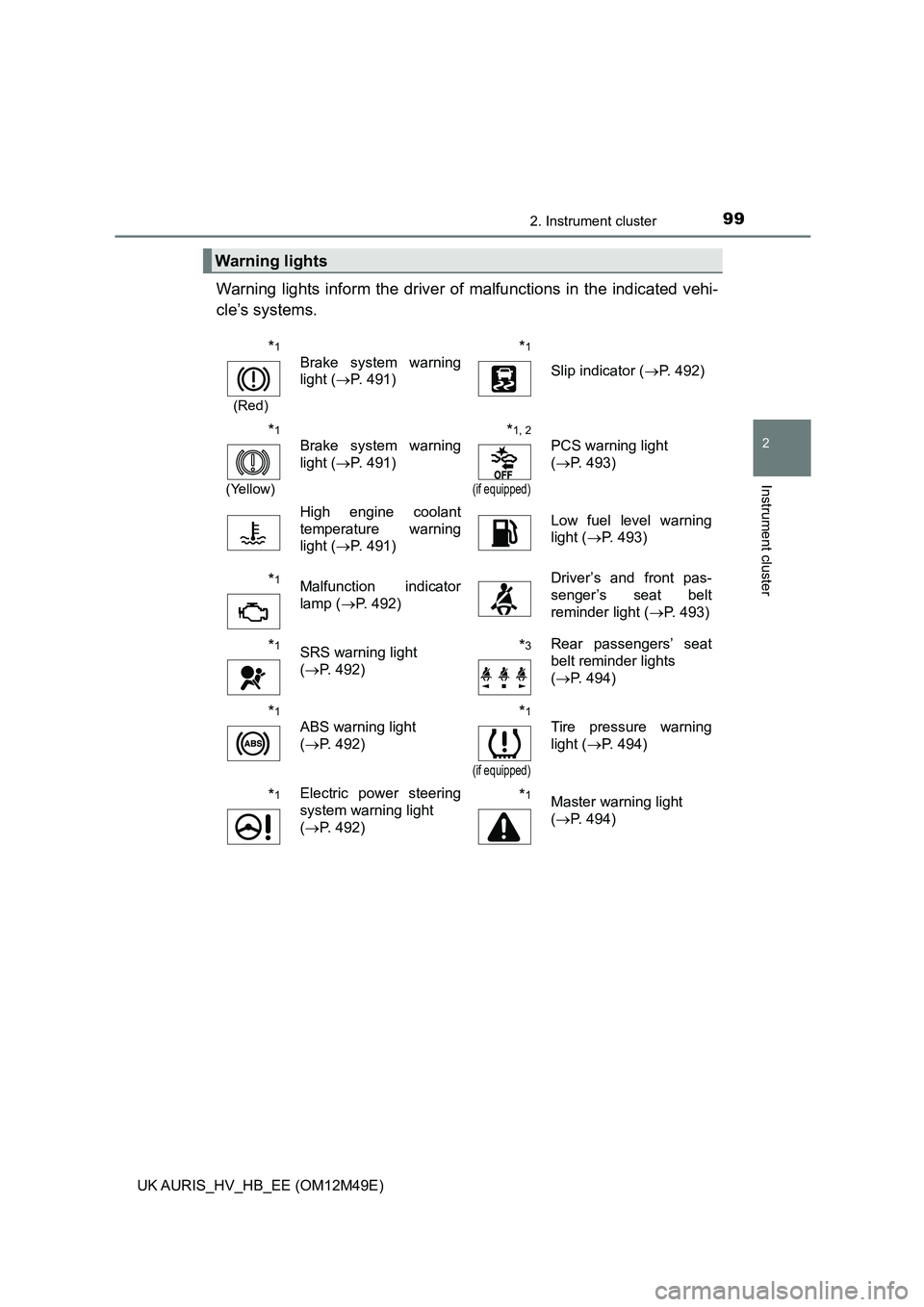
992. Instrument cluster
UK AURIS_HV_HB_EE (OM12M49E)
2
Instrument cluster
Warning lights inform the driver of malfunctions in the indicated vehi-
cle’s systems.
Warning lights
*1
(Red)
Brake system warning
light ( P. 491)
*1
Slip indicator (P. 492)
*1
(Yellow)
Brake system warning
light ( P. 491)
*1, 2
(if equipped)
PCS warning light
( P. 493)
High engine coolant
temperature warning
light ( P. 491)
Low fuel level warning
light ( P. 493)
*1Malfunction indicator
lamp ( P. 492)
Driver’s and front pas-
senger’s seat belt
reminder light ( P. 493)
*1SRS warning light
( P. 492)
*3Rear passengers’ seat
belt reminder lights
( P. 494)
*1
ABS warning light
( P. 492)
*1
(if equipped)
Tire pressure warning
light ( P. 494)
*1Electric power steering
system warning light
( P. 492)
*1Master warning light
( P. 494)
Page 312 of 592
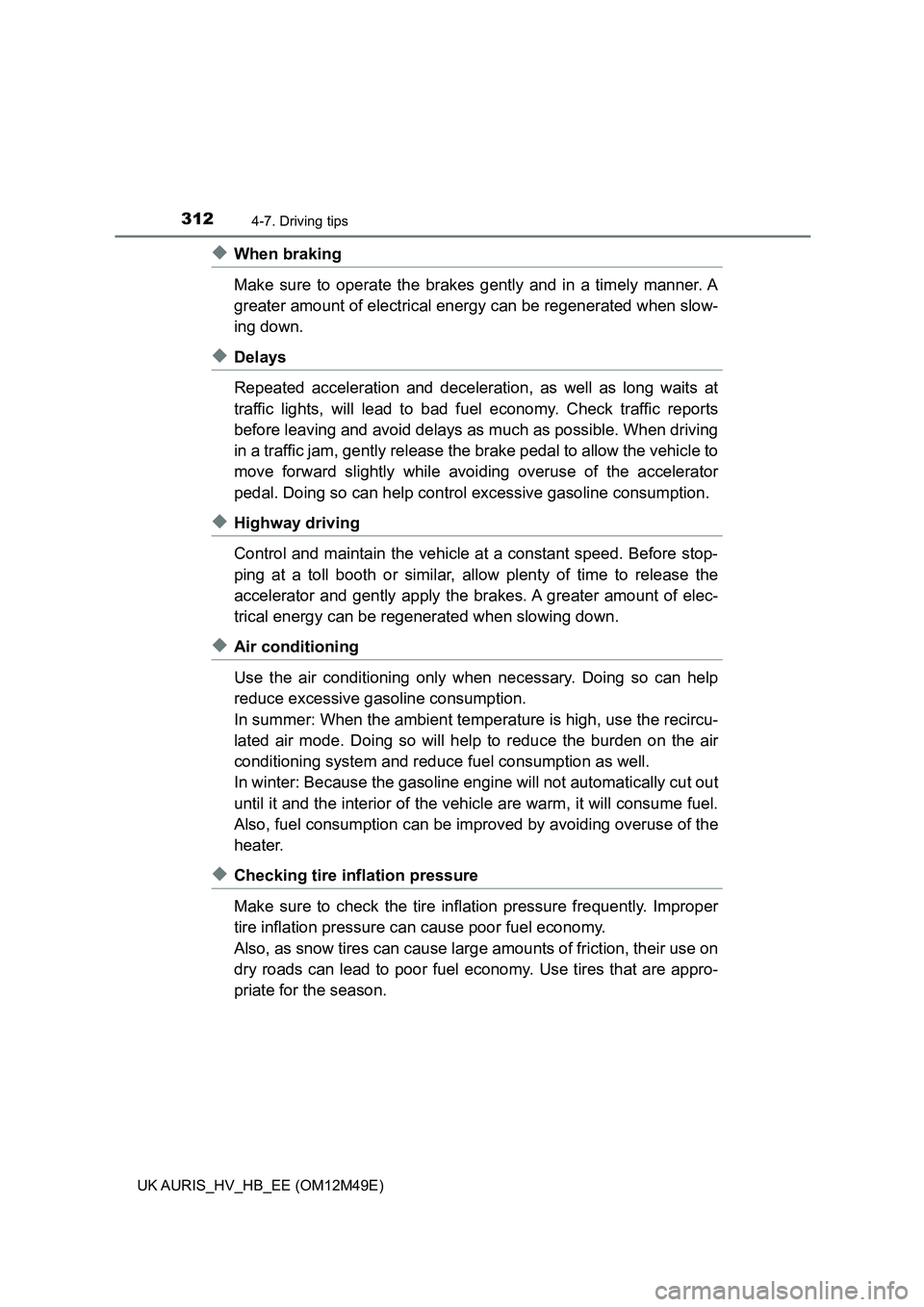
3124-7. Driving tips
UK AURIS_HV_HB_EE (OM12M49E)
◆When braking
Make sure to operate the brakes gently and in a timely manner. A
greater amount of electrical energy can be regenerated when slow-
ing down.
◆Delays
Repeated acceleration and deceleration, as well as long waits at
traffic lights, will lead to bad f uel economy. Check traffic reports
before leaving and avoid delays as much as possible. When driving
in a traffic jam, gently release th e brake pedal to allow the vehicle to
move forward slightly while avoi ding overuse of the accelerator
pedal. Doing so can help control excessive gasoline consumption.
◆Highway driving
Control and maintain the vehicle at a constant speed. Before stop-
ping at a toll booth or similar, allow plenty of time to release the
accelerator and gently apply the br akes. A greater amount of elec-
trical energy can be regenerated when slowing down.
◆Air conditioning
Use the air conditioning only when necessary. Doing so can help
reduce excessive gasoline consumption.
In summer: When the ambient temperature is high, use the recircu-
lated air mode. Doing so will help to reduce the burden on the air
conditioning system and reduce fuel consumption as well.
In winter: Because the gasoline engi ne will not automatically cut out
until it and the interior of the vehicle are warm, it will consume fuel.
Also, fuel consumption can be impr oved by avoiding overuse of the
heater.
◆Checking tire inflation pressure
Make sure to check the tire infl ation pressure frequently. Improper
tire inflation pressure can cause poor fuel economy.
Also, as snow tires can cause larg e amounts of friction, their use on
dry roads can lead to poor fuel economy. Use tires that are appro-
priate for the season.
Page 412 of 592
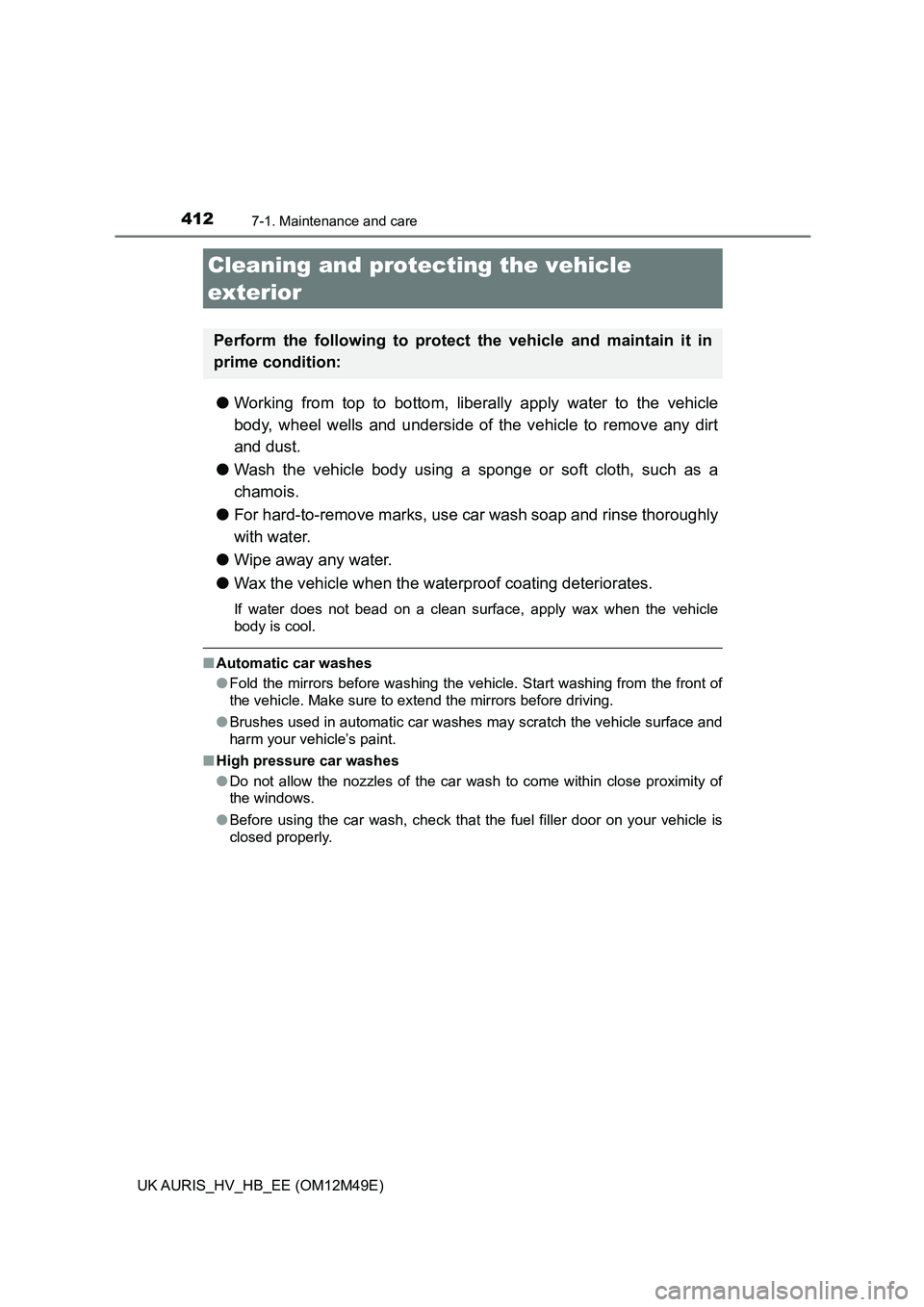
412
UK AURIS_HV_HB_EE (OM12M49E)
7-1. Maintenance and care
●Working from top to bottom, liberally apply water to the vehicle
body, wheel wells and underside of the vehicle to remove any dirt
and dust.
● Wash the vehicle body using a sponge or soft cloth, such as a
chamois.
● For hard-to-remove marks, use car wash soap and rinse thoroughly
with water.
● Wipe away any water.
● Wax the vehicle when the waterproof coating deteriorates.
If water does not bead on a clean surface, apply wax when the vehicle
body is cool.
■ Automatic car washes
● Fold the mirrors before washing the vehicle. Start washing from the front of
the vehicle. Make sure to extend the mirrors before driving.
● Brushes used in automatic car washes may scratch the vehicle surface and
harm your vehicle’s paint.
■ High pressure car washes
● Do not allow the nozzles of the car wash to come within close proximity of
the windows.
● Before using the car wash, check that the fuel filler door on your vehicle is
closed properly.
Cleaning and prot ecting the vehicle
exterior
Perform the following to protect the vehicle and maintain it in
prime condition:
Page 453 of 592
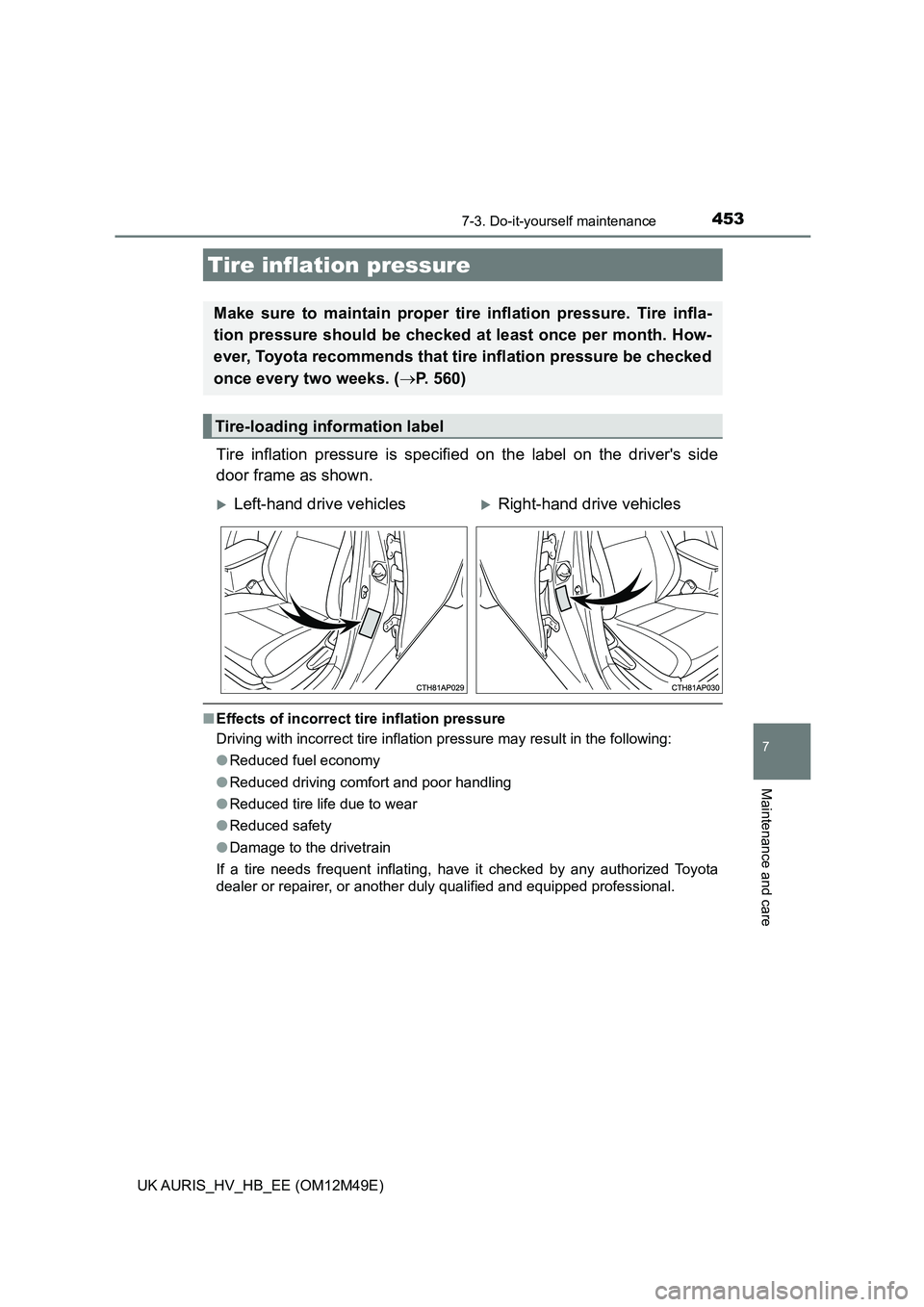
4537-3. Do-it-yourself maintenance
UK AURIS_HV_HB_EE (OM12M49E)
7
Maintenance and care
Tire inflation pressure is specified on the label on the driver's side
door frame as shown.
■ Effects of incorrect tire inflation pressure
Driving with incorrect tire inflation pressure may result in the following:
● Reduced fuel economy
● Reduced driving comfort and poor handling
● Reduced tire life due to wear
● Reduced safety
● Damage to the drivetrain
If a tire needs frequent inflating, have it checked by any authorized Toyota
dealer or repairer, or another duly qualified and equipped professional.
Tire inflation pressure
Make sure to maintain proper tire inflation pressure. Tire infla-
tion pressure should be checked at least once per month. How-
ever, Toyota recommends that tire inflation pressure be checked
once every two weeks. ( P. 560)
Tire-loading information label
Left-hand drive vehiclesRight-hand drive vehicles
Page 495 of 592

4958-2. Steps to take in an emergency
UK AURIS_HV_HB_EE (OM12M49E)
8
When trouble arises
■Front passenger detection sensor, seat belt reminder and warning
buzzer
● If luggage is placed on the front passenger seat, the front passenger detec-
tion sensor may cause the warning light to flash and the warning buzzer to
sound even if a passenger is not sitting in the seat.
● If a cushion is placed on the seat, the sensor may not detect a passenger,
and the warning light may not operate properly.
■ If the malfunction indicator lamp comes on while driving
The malfunction indicator lamp will come on if the fuel tank becomes com-
pletely empty. If the fuel tank is empty, refuel the vehicle immediately. The
malfunction indicator lamp will go off after several trips.
If the malfunction indicator lamp does not go off, contact any authorized
Toyota dealer or repairer, or another duly qualified and equipped professional
as soon as possible.
■ When the tire pressure warning light comes on (vehicles with a tire pres-
sure warning system)
Carry out the following procedure after the tire temperature has lowered suffi-
ciently.
● Check the tire inflation pressure and adjust it to the appropriate level.
● If the warning light does not go out after several minutes, check that the tire
inflation pressure is at the specified level and carry out initialization.
The warning light may come on again if the above operations are conducted
without first allowing the tire temperature to lower sufficiently.
■ The tire pressure warning light may come on due to natural causes
(vehicles with a tire pressure warning system)
The tire pressure warning light may come on due to natural causes such as
natural air leaks and tire inflation pressure changes caused by temperature.
In this case, adjusting the tire inflation pressure will turn off the warning light
(after a few minutes).
■ When a tire is replaced with a spare tire (vehicles with a tire pressure
warning system)
The compact spare tire is not equipped with a tire pressure warning valve and
transmitter. If a tire goes flat, the tire pressure warning light will not turn off
even though the flat tire has been replaced with the spare tire. Replace the
spare tire with the repaired tire and adjust the tire inflation pressure. The tire
pressure warning light will go off after a few minutes.
■ Conditions that the tire pressure warning system may not function prop-
erly (vehicles with a tire pressure warning system)
P. 443
Page 561 of 592
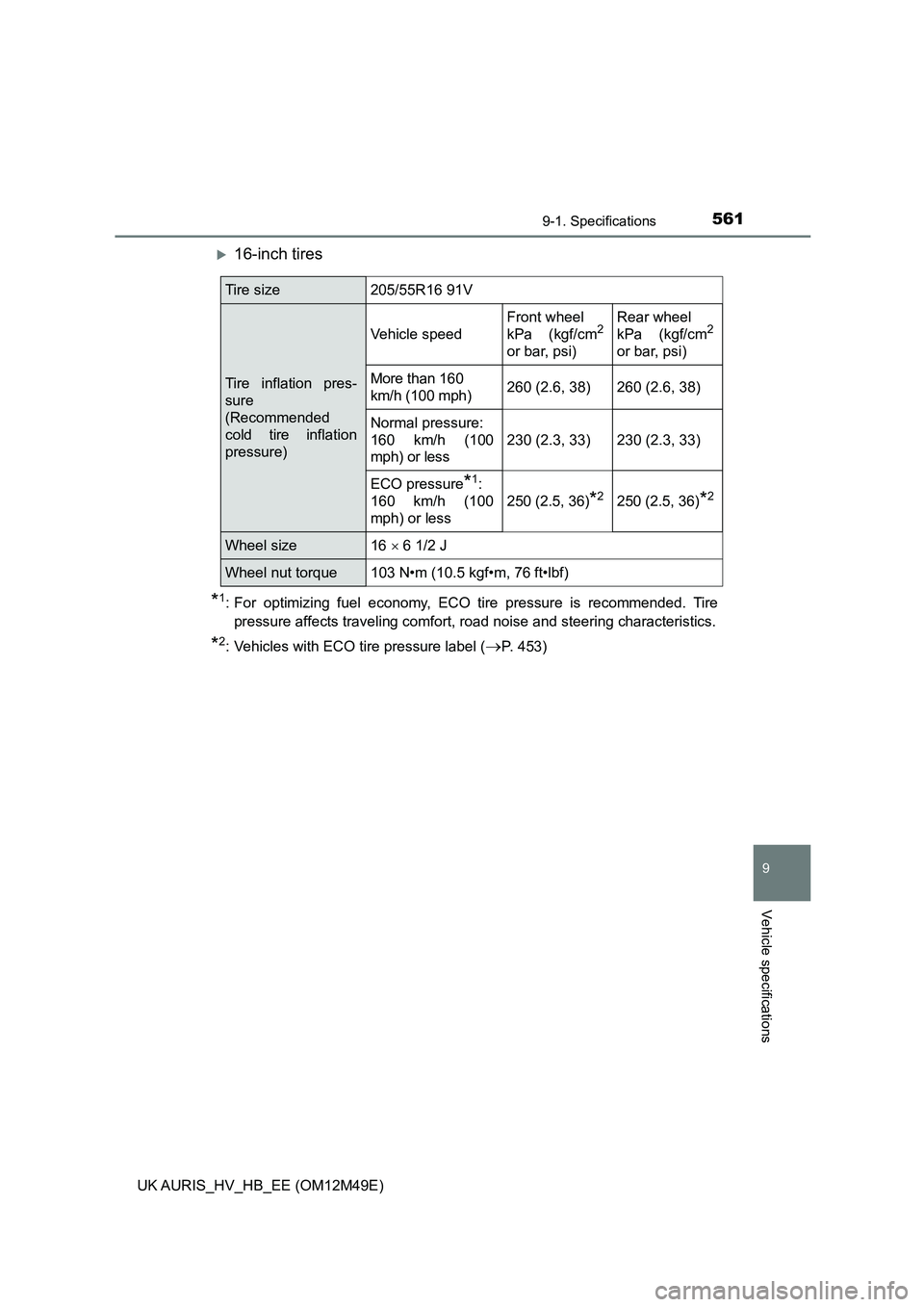
5619-1. Specifications
UK AURIS_HV_HB_EE (OM12M49E)
9
Vehicle specifications
16-inch tires
*1: For optimizing fuel economy, ECO tire pressure is recommended. Tire
pressure affects traveling comfort, road noise and steering characteristics.
*2: Vehicles with ECO tire pressure label (P. 453)
Tire size205/55R16 91V
Tire inflation pres-
sure
(Recommended
cold tire inflation
pressure)
Vehicle speed
Front wheel
kPa (kgf/cm2
or bar, psi)
Rear wheel
kPa (kgf/cm2
or bar, psi)
More than 160
km/h (100 mph)260 (2.6, 38)260 (2.6, 38)
Normal pressure:
160 km/h (100
mph) or less
230 (2.3, 33)230 (2.3, 33)
ECO pressure*1:
160 km/h (100
mph) or less
250 (2.5, 36)*2250 (2.5, 36)*2
Wheel size16 6 1/2 J
Wheel nut torque103 N•m (10.5 kgf•m, 76 ft•lbf)
Page 591 of 592

591Alphabetical index
UK AURIS_HV_HB_EE (OM12M49E)
Warning buzzers
Brake system ....... ................. 491
Electric power steering
system .......... ...................... 492
LDA
(Lane Departure Alert) ........ 265
Open back door .................... 130
Open door ............................. 127
Pre-crash warning ................. 252
RSA (Road Sign Assist) ........ 274
Seat belt reminder................. 493
Toyota parking
assist-sensor ...................... 284
Warning lights ............................ 99
ABS ....................................... 492
Brake system ....... ................. 491
Electric power steering
system .......... ...................... 492
High engine coolant
temperature warning light ... 491
Low fuel level ........................ 493
Malfunction indicator lamp .... 492
Master warning light .............. 494
PCS warning light ................. 493
Seat belt reminder light ......... 493
Slip indicator ......................... 492
SRS warning light ................. 492
Tire pressure warning light.... 494
Warning messages .................. 498
Washer.............................. 237, 241
Checking ............................... 432
Preparing and checking
before winter....................... 314
Switch ........................... 237, 241
Washing and waxing ............... 412
Weight....................................... 552
Wheels ...................................... 455
Replacing .............................. 455
Size ....................................... 560
Window glasses....................... 186
Window lock switch ................ 186
Windows ................................... 186
Power windows ..................... 186
Rear window defogger .......... 384
Windshield wipers ................... 237
Intermittent wiper with
interval adjuster .................. 237
Rain-sensing windshield
wipers ................................. 238
Winter driving tips ................... 314
Wireless remote control key... 120
Battery-saving
function ....................... 136, 156
Locking/Unlocking................. 124
Replacing the battery ............ 459
WMA disc*............................... 326
W
*: For vehicles with navigation/multimedia system, refer to “Navigation
and multimedia system Owner’s manual”.